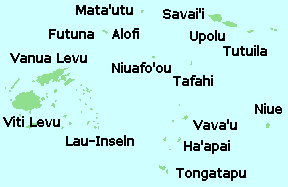Tu'i Tonga Empire Map

Annotation
The Tu’i Tonga Empire was an Oceanic maritime chiefdom centered on the island of Tongatapu, the main island of Tonga, and flourished between 1200-1500 CE. The empire arose when Samoa’s Tui Manu’a empire declined around 950s CE, when, according to oral tradition, ‘Aho’eitu, the son of a god and human woman, was the first leader of the empire and began expanding. The Empire was at its height under the 10th leader, Momo, and his son, Tuʻitātui, in the 11th and 12th centuries CE.
Decline began in 13-14th centuries due to internal pressures and war between the ruling family, including assassinations and tyrannical rule of certain rulers, however, the empire did not completely fall. For example, The Tu’i Tonga empire collected tribute called ‘Inasi, which was still being collected in 1777 when Captain James Cook visited the island. Instead, a new dynasty increasingly influenced by the Samoans rose beginning in the 16th century. Further intermarriage between the Tongan rulers with Samoan families further cemented the “Samoanized” government in Tonga, which still influences the kingdom today. The last Tu’i Tonga was Fatafehi Laufilitonga, the 39th leader, who lived between 1797 and 1865 and began his reign in 1827. During his rule, the title Tu’i Tonga had little political or spiritual power, and the title was abolished upon his death.
The empire was able to successfully expand and create a sphere of influence because of the imperial navy and the double canoes fitted for long-distance travel. This map illustrates the islands under the Tongan sphere and how the canoes and navies were paramount in expansion. Further, the Tongan empire demonstrates how Oceania was still home to large imperial powers that flourished for centuries and remained connected despite being home to island cultures.
Credits
"Tu'i Tonga Empire," Wikimedia Commons, 2006, https://en.wikipedia.org/wiki/Tu%CA%BBi_Tonga_Empire#/media/File:Tonga-Samoa-Fidschi.png.